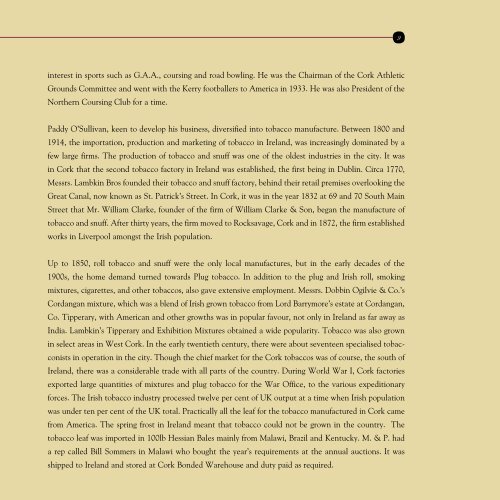M&P O'Sullivan Ltd 100 Years
You also want an ePaper? Increase the reach of your titles
YUMPU automatically turns print PDFs into web optimized ePapers that Google loves.
9<br />
interest in sports such as G.A.A., coursing and road bowling. He was the Chairman of the Cork Athletic<br />
Grounds Committee and went with the Kerry footballers to America in 1933. He was also President of the<br />
Northern Coursing Club for a time.<br />
Paddy O’Sullivan, keen to develop his business, diversified into tobacco manufacture. Between 1800 and<br />
1914, the importation, production and marketing of tobacco in Ireland, was increasingly dominated by a<br />
few large firms. The production of tobacco and snuff was one of the oldest industries in the city. It was<br />
in Cork that the second tobacco factory in Ireland was established, the first being in Dublin. Circa 1770,<br />
Messrs. Lambkin Bros founded their tobacco and snuff factory, behind their retail premises overlooking the<br />
Great Canal, now known as St. Patrick’s Street. In Cork, it was in the year 1832 at 69 and 70 South Main<br />
Street that Mr. William Clarke, founder of the firm of William Clarke & Son, began the manufacture of<br />
tobacco and snuff. After thirty years, the firm moved to Rocksavage, Cork and in 1872, the firm established<br />
works in Liverpool amongst the Irish population.<br />
Up to 1850, roll tobacco and snuff were the only local manufactures, but in the early decades of the<br />
1900s, the home demand turned towards Plug tobacco. In addition to the plug and Irish roll, smoking<br />
mixtures, cigarettes, and other tobaccos, also gave extensive employment. Messrs. Dobbin Ogilvie & Co.’s<br />
Cordangan mixture, which was a blend of Irish grown tobacco from Lord Barrymore’s estate at Cordangan,<br />
Co. Tipperary, with American and other growths was in popular favour, not only in Ireland as far away as<br />
India. Lambkin’s Tipperary and Exhibition Mixtures obtained a wide popularity. Tobacco was also grown<br />
in select areas in West Cork. In the early twentieth century, there were about seventeen specialised tobacconists<br />
in operation in the city. Though the chief market for the Cork tobaccos was of course, the south of<br />
Ireland, there was a considerable trade with all parts of the country. During World War I, Cork factories<br />
exported large quantities of mixtures and plug tobacco for the War Office, to the various expeditionary<br />
forces. The Irish tobacco industry processed twelve per cent of UK output at a time when Irish population<br />
was under ten per cent of the UK total. Practically all the leaf for the tobacco manufactured in Cork came<br />
from America. The spring frost in Ireland meant that tobacco could not be grown in the country. The<br />
tobacco leaf was imported in <strong>100</strong>lb Hessian Bales mainly from Malawi, Brazil and Kentucky. M. & P. had<br />
a rep called Bill Sommers in Malawi who bought the year’s requirements at the annual auctions. It was<br />
shipped to Ireland and stored at Cork Bonded Warehouse and duty paid as required.


